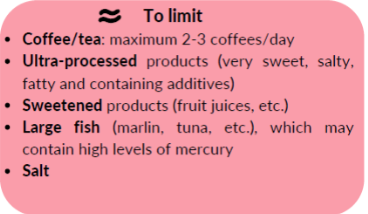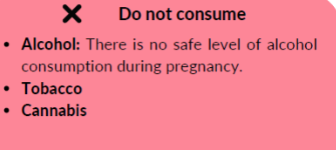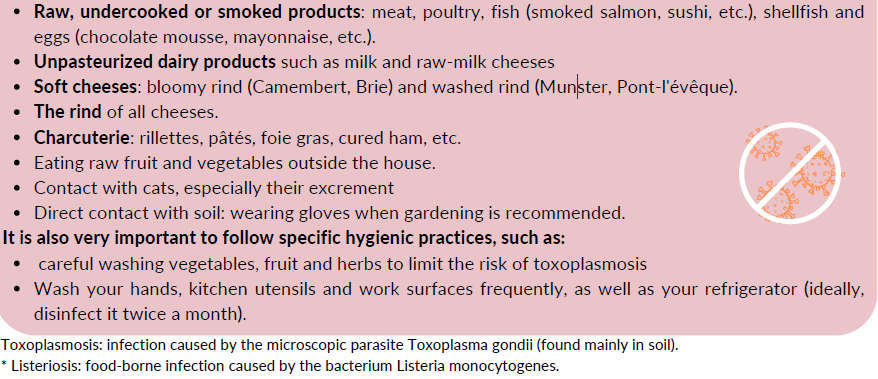Evolution of nutritional needs among women
Source : Nutriactis/Rouen-Normandie hospital
Summary
- Life cycle
- Nutrients whose needs change during pregnancy
- To be avoided for food safety reasons
- Breastfeeding
- Menopause
- Pathologies, women and nutrition
- Nutritional needs vary according to gender, but also according to the different stages of the life cycle. A healthy, balanced diet is essential, and the criteria defining it can vary. Indeed, men and women go through different periods of life, such as childhood or puberty, during which they need to adapt their diet.
- In addition to that women go through, or may go through, very specific stages such as pregnancy, breastfeeding or menopause, requiring very specific diets and lifestyle habits to keep their bodies in good health.
Life cycle
1-Puberty
Puberty is a period during adolescence where the body undergoes significant changes, in order to enable reproduction, and therfore, represents a period of rapid growth during which adequate nutrition is crucial to limit the risk of growth delay.
- An adapted, diversified and balanced diet is sufficient to cover the needs of teenagers. However, the growth spurt associated with adolescence calls for special nutritional requirements, particularly in amino acids for muscle growth; as well as calcium and vitamin D for bone growth. Adolescent girls are also at risk of iron deficiency.
- In addition to that, adolescence represents a critical period in the development of one’s body image, partial because of the substantial physical changes experienced in such a short period of time. Futhermore, the social pressure that often accompanies these changes, whether via the media or peers, can increase the risk of body dissatisfaction, which is a major risk factor for developing an eating disorder (ED).
The specific needs associated with puberty, as well as the risks of body dissatisfaction, affect adolescent boys and girls in different ways. For teenage girls, puberty leads to specific physical transition, such as breast development and increased fat deposits, particularly around the hips. In addition, social pressure, particularly applied on adolescent girls through the dissemination of thin ideals by media, contributes to the significantly higher prevalence of ED in adolescent girls compared to adolescent boys.
2- Pregnancy
A balanced and diversified diet is essential during pregnancy, as it covers the needs of both mother and child, thus promoting healthy development.
- During pregnancy, the organs and tissues of the fetus develop progressively, resulting in specific nutritional requirements for the pregnant woman. Certain nutrients are essential, and must be available in the appropriate quantities to allow proper fetal growth.
- Overall, a balanced, adequate and healthy diet can cover nutritional requirements? However, requirements for certain vitamins and minerals are particularly high. For example, folic acid supplementation is recommended as soon as the pregnancy is planned.
Nutrients whose needs change during pregnancy:

It is advisable to consult a doctor when planning a pregnancy, in order to access your diet and any need for supplements.
WARMING : supplementation without medical advice can be dangerous. For example, an excess of vitamin A (in the case of excessive and unnecessary supplementation) can particularly at the beginning of the first trimester of pregnancy, lead to congenital malformations. Always seek medical advice before taking any supplements.
Food reccommendations :
- To ensure that vitamin and mineral requirements are met, a healthy, balanced diet is essential. In addition to usual recommendations for a healthy diet, it is recommended to make a few changes to the eating habits :
To be avoided for food safety reasons
Pregnant women are more susceptible to food poisoning such as toxoplasmosis* and listeriosis**, whichcan have serious consequences on fetal development. Pregnant women must therefore be particularly vigilant. It is advisable to avoid:
- Il est également très important d’avoir des pratiques hygiéniques spécifiques telles que:
- Laver soigneusement légumes, fruits et herbes aromatiques pour limiter le risque toxoplasmose
- Laver fréquemment ses mains, les ustensiles de cuisines, le plan de travail mais aussi votre réfrigérateur (désinfecter votre réfrigérateur idéalement 2 fois par mois)
- *Toxoplasmose: infection due à un parasite microscopique le toxoplasma gondii (présent notamment dans la terre)
** Listeriose: infection d’origine alimentaire, causée par la bactérie Listeria monocytogenes.
To limit

Do not consume

To be avoided for food safety reasons
Pregnant women are more susceptible to food poisoning such as toxoplasmosis* and listeriosis**, whichcan have serious consequences on fetal development. Pregnant women must therefore be particularlyvigilant. It is advisable to avoid:

3- Breastfeeding
- Breast milk is the ideal source of nutrition for an infant’s. It adapt to infant’s nutritional and immunological needs, as its composition evolves naturally at each stage of development. Breast milk contain bioactive molecules that enable optimal maturation of the infant’s immune system, reducing the risk of infection and inflammation.
- WHO and UNICEF recommend that breastfeeding of newborns begins within the first four hours of life (colostrum: milk of the first days) and remains exclusive for 6 months. However, breastfeeding remains a personnal decision taken by mother.
The benefits of breastfeeding for mother and child are well established:
For the child: Breastfeeding promotes optimal growth, reduces infant mortality (a 4 to 10-fold reduction in low-income countries), provides primary prevention of acute illnesses such as infections (75% less diarrhea and 57% less respiratory infections) and chronic deseases such as diabetes (32% less risk of type 2 diabetes), but also reduces the risk of developing asthma (18-20% less asthma), allergies and childhood obesity (1 month of beastfeeding is associated with a 4.0% reduction in risk of obesity).
The breastfeeding mother: Breastfeeding reduces post-partum bleeding, helps reduce the volume of the uterus following childbirth and may also reduce the risk of certain cancers (7% reduction in breast cancer, 18% recuction in ovarian cancer) and the risk of hypertension and type 2 diabetes.
Dietary recommandations:
- Producing milk require both energy and water, which in turn increases the needs of breastfeeding mother. Here are a few recommendations for breastfeeding:
- Eat a balanced and varied diet to satisfy the mother’s needs, but also to expose the infant to a diversity of flavors, which will facilitate dietary diversification.
- Stay well hydrated: around 16 cups of water a day.
- Avoid large fish such as sea bass, tuna, swordfish, and carp, which may contain high levels of mercury.
- Reduce caffeine consumption (coffee, tea, Coca-Cola : maximum 2 or 3 cups of coffee/day).
Moreover, certain molecules such as nicotine, THC and alcohol can pass from mother to child. As in pregnancy, don’t hesitate to ask your doctor for advice on alcohol, tobacco and cannabis use.
4- Menopause
Menopause is a period in a woman’s life marked by the absence of menstruation for at least a year, without any identified cause, and occurring between the ages of 45 and 55. Menstrual irregularities may be observed prior to menopause, sometimes lasting several years; this period is known as perimenopause. The hormonal changes associated with menopause can cause various metabolic changes, such as reduction in basal metabolism (basic energy requirements), reduced satiety, changes in body composition and fat mass distribution, and weight gain.
Menopause may therefore be associated with an increased risk of obesity, type 2 diabetes, cardiovascular diseases and hypertension. The risk of developing these pathologies, and the progression of their symptoms can be significantly improved by eliminating and reducing dietary risk factors. Nutrition therefore plays an essential role in the prevention and management of pathologies associated with menopause (comorbidities)
Some nutritional advice for menopause:
- Reduce consumption of added sugar, saturated fatty acids, salt and alcohol.
- Eat a healthy, balanced diet, and stay well hydrated.
- Eat foods rich in omega-3 fatty acids, such as oily fish and nuts (walnuts, almonds, etc.)
- Increase fiber intakes (fruits, vegetables, legumes, wholegrain starch)
- Favoring dairy products (milk, yogurt, cheese, etc.)
- Prefer poultry and limit consumption of red meat (beef, pork, offal, etc.)
Pathologies, women and nutrition
- Polycystic ovary syndrome (PCOS) is the most common hormonal disease (between 4% and 20%, depending on the diagnostic criteria used) in women of childbearing age (first menstrual period to menopause), with physiological (pre-diabetes, weight gain, risk of cardiovascular disease…) and psychological (depression, anxiety, eating disorder…) consequences that can impair women’s quality of life. Weight and lifestyle management (diet, physical activity) is the first-line of treatment for PCOS.

- Endometriosis is a chronic inflammatory disease that affects 6-10% of women, and can appear as early as the first menstrual period and last until the menopause. It is characterised by the development of tissue similar to the uterine mucosa outside the uterus. The etiology (cause) of endometriosis is not fully understood. A few study have shown that high consumption of trans and saturated fatty acids (processed procucts: potato chips, pastries, chocolate bars…) and red meat may be associated with an increased risk of endometriosis, while a diet rich in fiber (fruit, vegetables, legumes…), antioxidants (fruits, vegetables…), and vitamin D (dairy products…) may have positive effects on prevention and symptom reduction. However, these studies are inconclusive, and more studies are needed to better understand the link between nutrition and endometriosis.
Conclusion
Women go through a number of different periods during their lives, which can have an impact on their nutrition. Furthermore, they are sometime confronted with pathologies such as endometriosis or PCOS. To cope with all these changes, diet and lifestyle are real allies to a good health!
- Women also play an essential role in household food pratices (shopping, organization, cooking…) and are still very often in charge of food within families. In fact, women are very often still the primary responsible for their children’s diet, including its day-to-day organization. Find out more about “Education and nutrition” in our next article
-
Download this article in PDF form
pdf – 2 MB